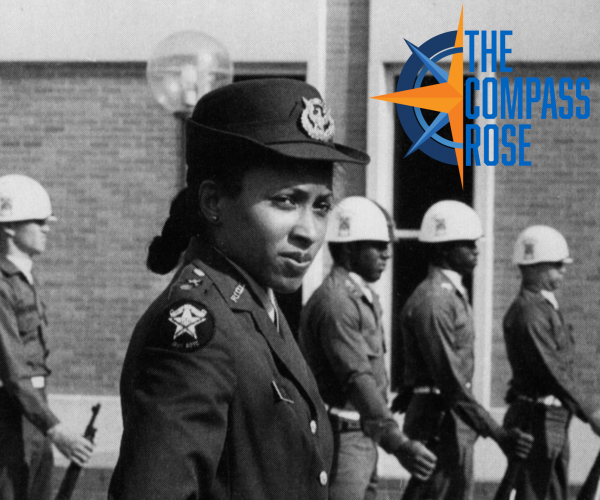
by Michael Barera


by Michael Barera
The purpose of The Compass Rose is to raise awareness of Special Collections' resources and to foster the use of these resources. The blog series also reports significant new programs, initiatives, and acquisitions of Special Collections.
In observance of Armed Forces Day on Saturday and Memorial Day later this month, this blog post commemorates and celebrates the University of Texas at Arlington (UTA)'s Reserve Officers' Training Corps (ROTC) and military science at the university more generally. The cadet corps on campus has a long and rich history, going back all the way back to the establishment of Carlisle Military Academy as a private military academy by Colonel James M. Carlisle in September 1902 (Saxon 1995, p. 9). The preparatory school was molded by Carlisle's educational philosophy, which featured a balance of intellectualism and military training that was intended to instill discipline in students and ultimately prepare them to enroll in colleges (Saxon 1995, p. 10). Carlisle Military Academy offered military science classes and required male students to wear their cadet uniforms at all times and participate in military drill on a daily basis (Saxon 1995, p. 11). In March 1907, United States Army lieutenant Harry King lauded the school as one of the best private preparatory military academies in the United States (Saxon 1995, p. 13). However, by 1911 Carlisle Military Academy became hounded by debt, lawsuits, and allegations of inefficiency, and in 1913 it ceased to exist when a court ordered it to sell its property to satisfy obligations to banks and lienholders, at which point it was more than $20,000 in debt (Saxon 1995, p. 15).
After Carlisle Military Academy closed, two more private preparatory military academies stood on the site of what is now UTA. Arlington Training School was founded by Henry Kirby Taylor in September 1913 (Saxon 1995, p. 21), and Taylor conceived of it as a school for "gentlemen's sons," not a reformatory for "vicious boys" (Saxon 1995, p. 23). Like its predecessor, Arlington Training School ended in financial difficulties and lawsuits (Saxon 1995, p. 27), with Taylor breaking the contract he had with the school's stockholders and refusing to lease the school after the conclusion of the 1915-16 academic year (Saxon 1995, p. 28). Its successor was Arlington Military Academy, which was established by John B. Dodson. It existed for a single academic year in 1916-17, thus becoming the final private military school on the site of present-day UTA (Saxon 1995, pp. 28-29). Like its two predecessors, it also emphasized military exercise and overall discipline for its students, but it had a disappointing (yet unknown) enrollment before closing its doors in 1917 (Saxon 1995, p. 29).
In March 1917, Grubbs Vocational College (GVC) was organized as a junior college and an Arlington branch campus of the Agricultural and Mechanical College of Texas, which later became Texas A&M University (Saxon 1995, p. 36). At GVC, the cadet program was mandatory for all male students, and it consisted of a battalion with four companies and eight platoons (Saxon 1995, p. 45). The college began a Student Army Training Corps (SATC) in 1918, through which cadets joined the United States Army as privates (Saxon 1995, pp. 41-42). Total participation in GVC's SATC was 62 students, but none experienced active duty in Europe before Armistice Day ended World War I in November 1918. The entire campus contributed to the war effort, including by buying Liberty bonds and war savings stamps, donating to the American Red Cross, and conserving food (Saxon 1995, p. 42). After the war, during the 1919–20 academic year, GVC created a program for disabled soldiers returning home (Saxon 1995, p. 43). GVC established a Reserve Officers' Training Corps (ROTC) in fall 1921. The War Department assigned Captain Carl A. Bishop to lead the new ROTC program, and he also created a new rifle team at GVC (Saxon 1995, p. 46).
In 1923, GVC was renamed North Texas Agricultural College (NTAC) due to its expansion beyond vocational education, the development of its liberal arts curriculum, and its rapid expansion in enrollment (Hamlett). NTAC formed its ROTC program in August 1923 (Barker & Worcester 2015, p. 39), which was mandatory for all male students who were not married or over 30 years old (Saxon 1995, p. 68). The program established a drill team in 1933, which was named the Sam Houston Rifles (and nicknamed the "Jodies") in 1937 (Saxon 1995, p. 68). The Sam Houston Rifles would become the oldest and perhaps the most prestigious part of the ROTC program (Saxon 1995, p. 68), and they would perform in Dwight D. Eisenhower's 1957 presidential inauguration (Barker & Worcester 2015, p. 40). NTAC experienced a substantial decline in enrollment due to World War II (Saxon 1995, pp. 62–63). Changes at NTAC due to the war included new subjects (such as aerial photography, camouflage, and flight training), while women were allowed to take engineering courses for the first time in the college's history (Saxon 1995, p. 63). The ROTC cadets studied commando techniques, the Japanese language, and jujutsu (Saxon 1995, p. 63), while a total of seven Navy and Marine platoons were assigned to campus during 1944 and 1945 after NTAC was designated a Navy V-12 instructional center in 1943 (Saxon 1995, p. 64).
In September 1949, NTAC was renamed Arlington State College (ASC) (Hamlett), largely because agriculture was no longer a major part of the school's curriculum (Barker & Worcester 2015, p. 35). ASC made the cadet corps optional for male students in 1954 (Saxon 1995, p. 78). The modern ROTC program was founded at ASC in 1956. It has continued to serve the university since it left the Texas A&M University System to join the University of Texas System in 1965 and adopted its current name, the University of Texas at Arlington (UTA), in 1967 ("About - Military Science"). The UTA Corps of Cadets purchased six Korean War-era howitzer cannons in 1983, which are known as the Carlisle Cannons and are fired on special occasions (Barker & Worcester 2015, p. 108). During the 2013-14 academic year, the ROTC program resurrected the Sam Houston Rifles (Reeves). At celebrations for the centennial of the national ROTC program in March 2016, cadets fired the Carlisle Cannons (Musselman).
Timeline showing major milestones for ROTC/military science at UTA.
Barker, Evelyn; Worcester, Lea (2015). University of Texas at Arlington. Charleston, South Carolina: Arcadia Publishing.
Hamlett, Samuel B. (June 15, 2010). "University of Texas at Arlington." Handbook of Texas Online. Texas State Historical Association. Accessed May 6, 2021.
Musselman, Anthony (March 5, 2016). "UTA ROTC celebrates 100 years." The Shorthorn. Accessed May 6, 2021.
Reeves, Sara (October 22, 2013). "Cadets resurrect drill team." The Shorthorn. Accessed May 6, 2021.
Saxon, Gerald D. (1995). Transitions: A Centennial History of the University of Texas at Arlington, 1895–1995. Arlington, Texas: UTA Press.
University of Texas at Arlington. "About - Military Science." Accessed May 5, 2021.
Add new comment